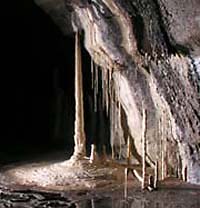Local
Geology and Cave Formation
|
Back to the tour?
|
|
Local Geology
~ The
Ogof Ffynnon Ddu cave system lies within the
Brecon Beacons National Park in South Wales, United
Kingdom. Consisting predominantly of Millstone Grit
and Carboniferous Limestone, this area is bordered
to the north by Old Red Sandstone, and to the
south by the South Wales Coalfields.
~ By far the vast majority
of caves in the UK (and indeed the rest of the world)
are formed in Limestone, by the chemical and physical
erosion of flowing water. This particular band was laid
down around 350 million years ago at a time when the
area was in fact close to the equator, under shallow
warm seas. Owing to continental drift, this has
now turned up in our rather cooler (!) climate.
|
|
|
What's so special about Limestone?
~ Limestone
is a sedimentary rock and is generally
composed of the mineral calcite, formed of the
skeletons of millions of marine organisms that collect
at the bottom of the sea. With time and pressure these
consolidate and harden. (With more heat and pressure,
marble is formed).
~ Rainfall absorbs carbon
dioxide from the air, creating a mild solution of
carbonic acid. It is also believed that rotting
vegetation in peat bogs or soil, produces organic acids
that are also capable of attacking limestone. This would
explain why jungle covered karst regions in the
tropics (with high rainfall), often produce such dramatic
caves. eg Sarawak, Mexico.
~ The stream which flows into OFD first passes
through a large peat bog, and so the water is very aggresive,
chemically (!) before disappearing underground.
|
|
Passage Types
~ Most
limestone contains small cracks or fissures,
and these give the water small channels to explore.
The action of this slightly acidic water is to gradually
dissolve the rock, and widen the cracks and crevices.
Soon any larger channels begin to dominate and to take
the majority of the flow, taking in water from side
branches, and swelling as a result.
~ If at this stage, the
underground channels are entirely full of water, then
they will grow in size over their entire surface and
tend to form circular phreatic tunnels. Where
there is an air surface above the water, then its action
will be to cut downwards, creating vadose canyons.
It is possible for a phreatic tube/tunnel to run uphill
as well as downhill with the water flow, as it can behave
like a pipe, as long as the final outflow is well below
the inflow.
|
|
|
|
|
Vadose Canyon
|
Flooded Phreatic Tube
|
|
~ Vadose
canyons always trend downhill with water
flow. Often a vadose passage will have started
life as phreatic, but then due to a reduction
in water flow, an air space develops and the
stream begins to cut downwards.
|
|

|
Cave Formations
~ As
water passes through the cave it becomes more
and more saturated with bicarbonate of lime from the
dissolved rock. Water dripping from the roof or trickling
down the walls, evaporates leaving behind a slow-growing
deposit of calcite. When they are downward-growing they
are stalactites. Drips landing on the floor can
form upward-growing stalagmites. If these then
meet they form a column. Trickles down the walls
can form curtains, whereas thin films of water
can form flowstone.
|
|
References:
Karst Geomorphology ~ J N Jennings ISBN 0 631 14032
9
Rocks, Minerals and Fossils of the World ~ Roger Phillips
ISBN 0 330 29953 0
Caves and Karst of the Brecon Beacons National Park
(BCRA)
~ Michael J Sims ISBN 0 900 26520 5
|
|
PCW 2004
|
|